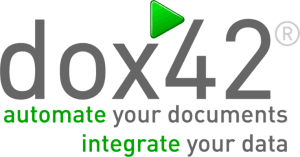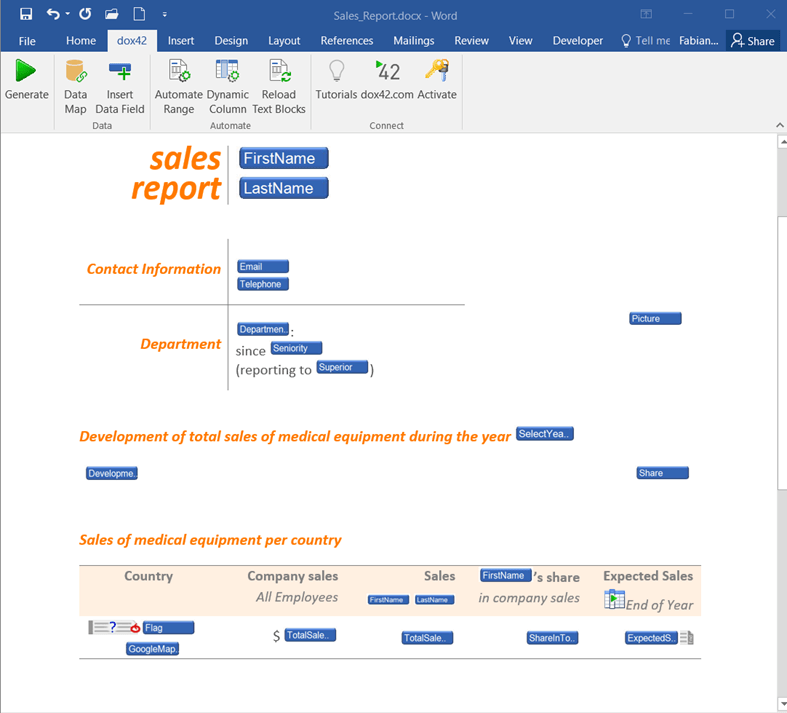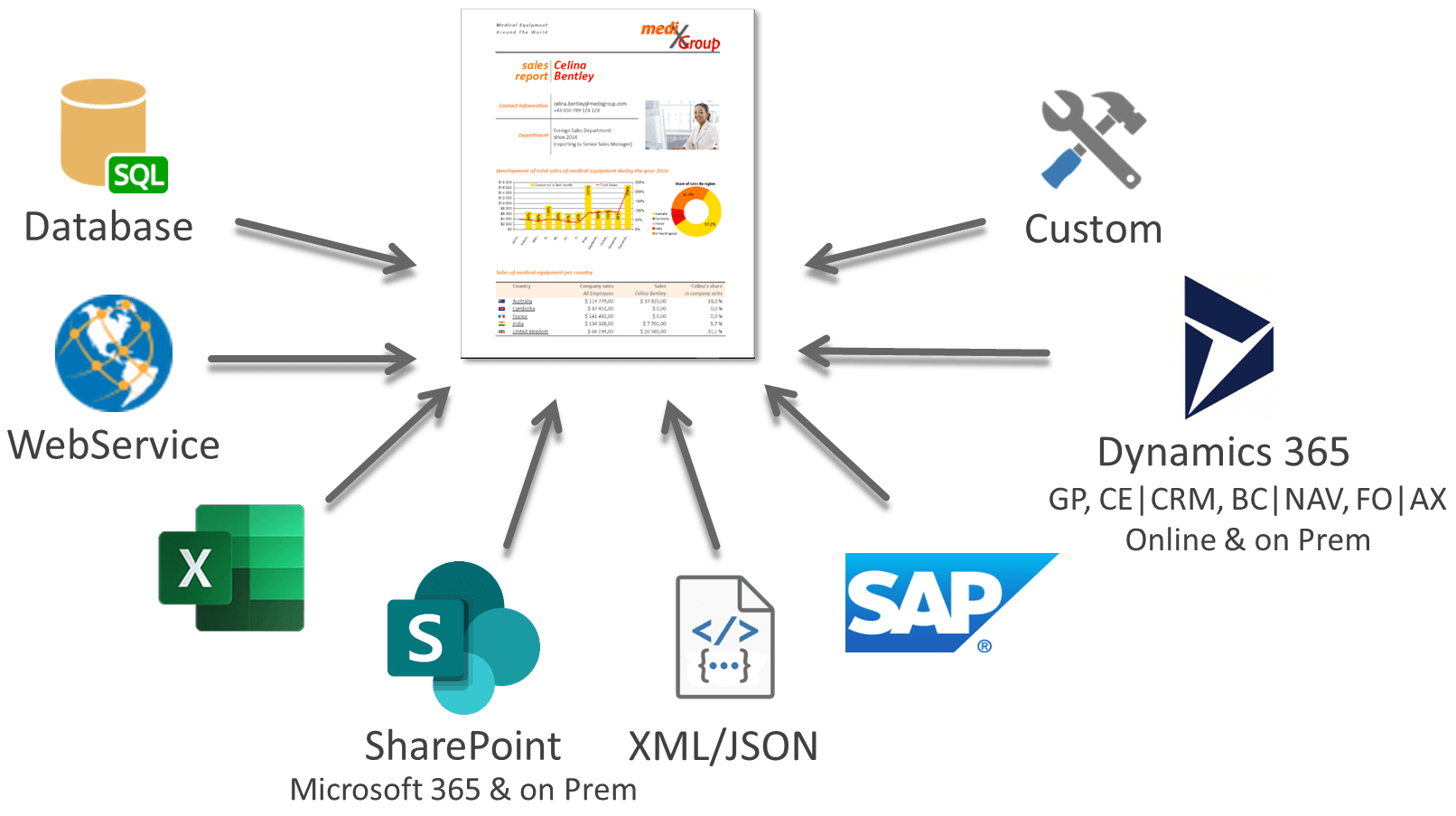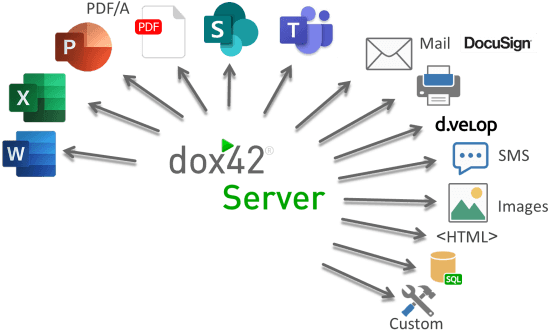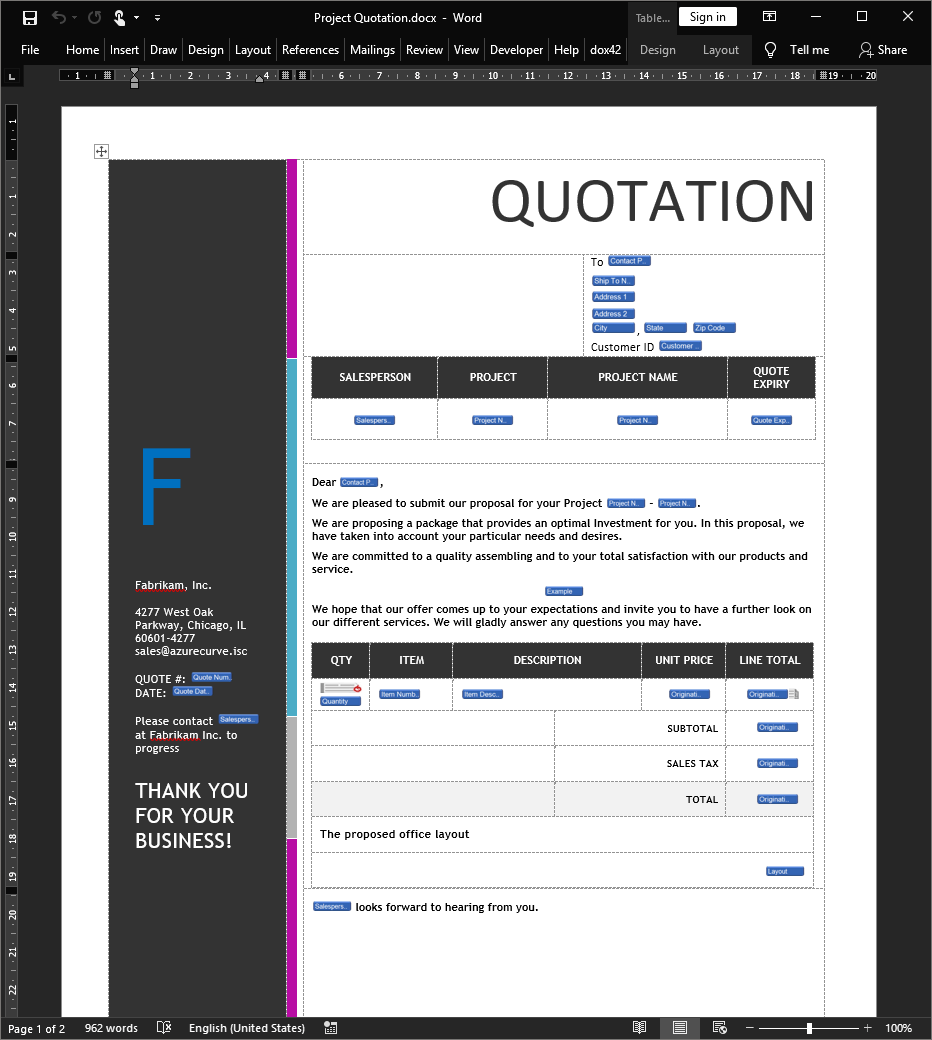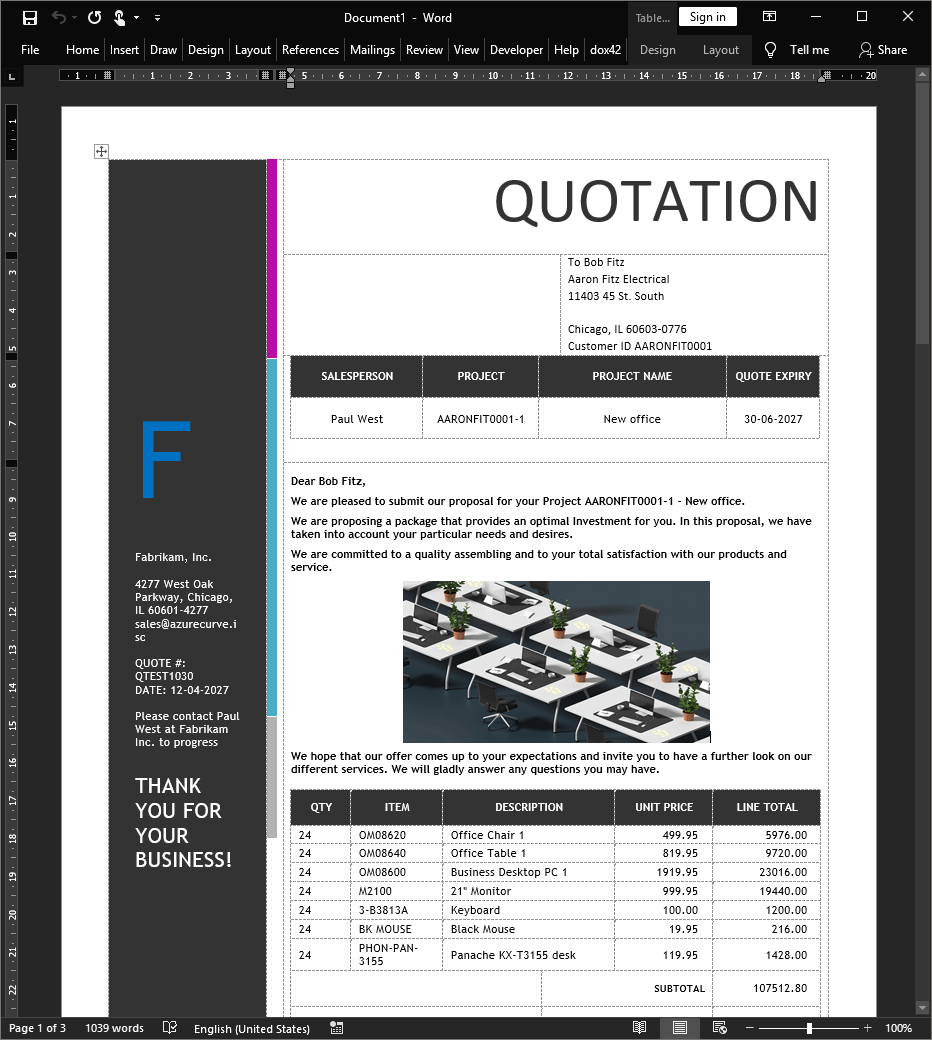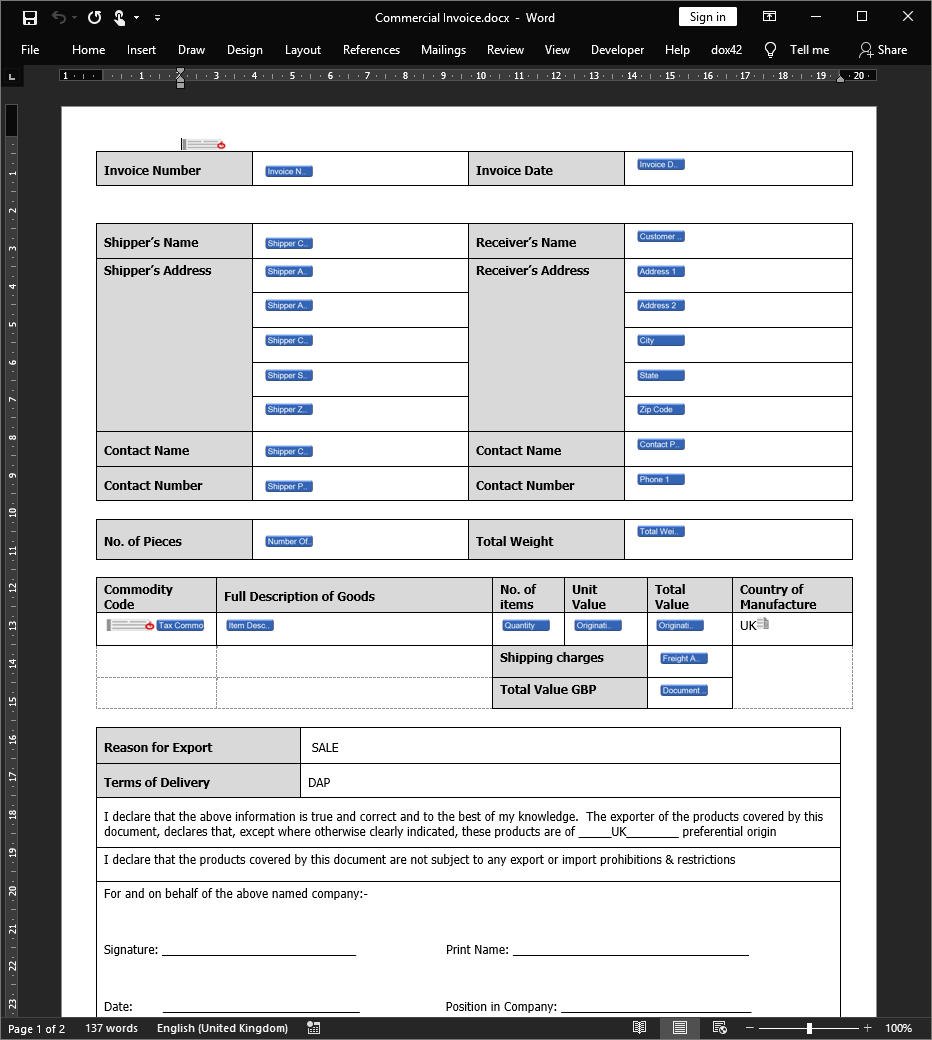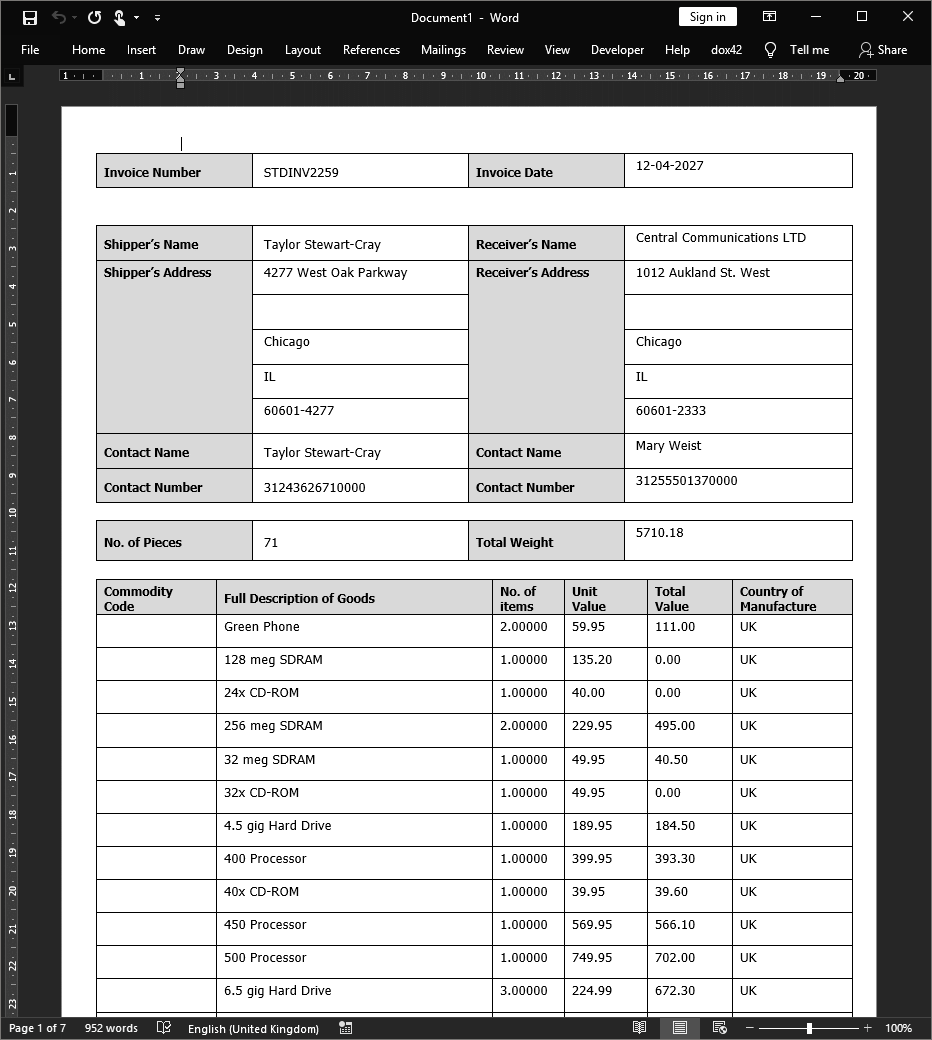 In our most recent webinar, we took a look at Powerful document generation for Dynamics GP. In this webinar, we covered how dox42 can be used to design attractive document templates in Microsoft Office and integrate data from Microsoft Dynamics GP and other systems such as SharePoint or Microsoft 365. If you want to catch up on this, or any other, webinar, you can do so here.
In our most recent webinar, we took a look at Powerful document generation for Dynamics GP. In this webinar, we covered how dox42 can be used to design attractive document templates in Microsoft Office and integrate data from Microsoft Dynamics GP and other systems such as SharePoint or Microsoft 365. If you want to catch up on this, or any other, webinar, you can do so here.
In this blog post, I am going to recap the webinar and show the benefits and some example uses of dox42 for generating documents with data from Dynamics GP and other systems:
- Introducing dox42
- Examples of how dox42 can be used
- Template Design
- Integrate data from various sources
- Automate your output
- Key benefits
- Examples from Dynamics GP
- Conclusion
Introducing dox42 ^
dox42 are headquartered in Vienna Austria and sell dox42 through a partner channel using companies such as ISC Software. It allows you to generate individualised documents from all your existing systems, including Microsoft Dynamics GP, automatically. Offers, quotes, contracts, inspections or server-reports, presentations, Excel-charts and insurance policies; dox42 is a flexible, powerful and intuitive application which allows you to use the common interface of Microsoft Word, Excel or PowerPoint to design document templates.
Documents can be generated directly from the template or via a call to a Rest API, meaning it is easy to integrate the production of templates in dox42 from one of the source systems. You can easily create data sources to pull relevant information from a multitude, or only one, system depending on the document being created.
Output can be produced as PDFs which are automatically emailed to the recipient or saved to SharePoint or a network share or even printed. dox42 supports all common output formats.
In addition, images or other elements can be automatically added to templates and there is no limit to the number of pages you might include on a document, so to give one example, you can easily include terms and conditions in an appendix of a quote.
dox42 is available either in the cloud or as an on-premise installation. In the demo I used an on-premise version so as to minimise data flow during the demo (and so I can do demos in future when I might not have an Internet connection).
Examples of how dox42 can be used ^
dox42 can be used to generate documents from several systems, pulling the data together into an attractively presented layout. Examples of how dox42 has been used include:
- Offers, Orders, Invoices
- Quality and Audit Reports
- Waybill with Barcodes
- Sales Presentations
- Project Management Reports
- Employment Contracts
- Financial Investment Proposal as PowerPoint
- Contracts, Rental Contracts, Employment Contracts
- Depot Evaluation
- Financial Reports
- Insurance Policies
- Real Estate Valuation
Template Design ^
Document templates for dox42 are created in Microsoft Word, Excel or PowerPoint making them easy for end-users to create and maintain without the need for a developer.
Formatting is done using the standard Office functionality and data fields are added as mail merge tags which are replaced at runtime. A template like this:
can become an output like this when the document is generated:
Integrate data from various sources ^
Data can be integrated from a multitude of different sources depending on the type of document being created allowing you to easily create simple or complex documents:
Data sources can includes SQL databases, web services, Microsoft Excel, SharePoint, XML/JSON files, SAP, Dynamics GP/BC or FO) or custom data sources such as images.
Automate your output ^
dox42 can be automated to output a document to one or more data sources:
Outputs can include Microsoft Word, Excel or PowerPoint, PDF, SharePoint, Microsoft Teams, email (signed with DocuSign), d.velop. SMS, images HTML, SQL Server or a custom output such as a network share.
Key benefits ^
dox42 has a number of keys benefits:
- Template design in Microsoft Word, Excel, PowerPoint – let business users create complex, detailed document templates by themselves — as they are already used to work with Microsoft Word, Excel and PowerPoint. The data is inserted via drag & drop and templates can easily be designed in corporate design.
- Many output formats – PDF, MS Office, Word, Excel, PowerPoint, saving directly to SharePoint or sending as an E-Mail, HTML or Print. The choice is yours, dox42 supports all common output formats.
- Flexible system integration – dox42 integrates with all systems like Microsoft Teams, Workflows, SharePoint, SAP, MS Dynamics 365 for CE / CRM, MS Dynamics 365 BC / NAV, MS Dynamics 365 FO | AX and many other systems without any extra programming needed.
- Strong support through communities – you can rely on leading integration partners to realise your dox42 projects. dox42 is global sponsor of the Microsoft Dynamics 365 Community, Main sponsor of many SharePoint Events and SAP Partner.
- Options for on-premise or secure in the Cloud with dox42 – use dox42 Online together with Microsoft-Cloud Applications like Microsoft SharePoint Online or Dynamics 365 completely impersonated as dox42 Online is using the permissions of the logged in Microsoft user. Also dox42 Online doesn’t save any data and uses end-to-end encryption.
- Intelligent, high quality design – generate high quality and intelligent documents for your customers, including data, dynamic tables, diagrams, images, bar codes, text modules, conditions and calculations from all your data sources automatically.
- Up-to-date corporate design – update corporate design elements like headers- or footers from one source automatically for all your dox42 templates.
- Be able to react quickly by changing complex documents without needing a developer.
- Save lots of time – using dox42 you get rid of tedious copy-pasting. Make better use of your resources and concentrate on the tasks at hand..
- Eliminate copy & paste errors – wrong data in your document or sending to the wrong recipient is embarrassing and can become quite expensive.
- Reduce the number of templates – using intelligent conditions and text modules allows for significant reduction of required templates and thus saves management from extra workload.
- Extend dox42 yourself – numerous partners have developed own plug-ins for dox42. Just in case, if you ever miss a functionality, you can create your own plug-in, so you will never be stuck
Examples from Dynamics GP ^
In the webinar we shows two examples:
- Quotation pulling data from Dynamics GP and images from a network share.
- Commercial Invoice pulling data from Dynamics GP and a separate stock file.
Quotation ^
For the first example we showed an attractive quotation document which pulled data mainly from Microsoft Dynamics GP, but also loaded images in from a network share.
The template was designed in Microsoft Word:
I did a couple of small customisations to Microsoft Dynamics GP to allow the template to be easily generated.
The first was to amend the Sales Transaction Entry window only visible when a quotation was loaded, to add a print button on the window so a user looking at the quotation to generate it by clicking the button; I could have integrated this with the standard print functionality instead.
The second change I made was using SmartList Builder to create a new Quotations SmartList object which had a drill down to the quotation.
Once generated the quotation pulled through the data from Dynamics GP as well as a sample iage and room layout from a network share based on some data in the Sales Transaction Entry – User Defined window:
The generated document also included a page of terms and conditions.
Commercial Invoice ^
The second example we showed was a commercial invoice, which has become a more common request for clients who ship outside of the UK.
The template in this case is more functional than attractive, but included all of the sales data from Dynamics GP as well as some data pulled in from a secondary source:
The commercial invoice template was set up to generate a batch of invoices instead of a single document. This allowed me to make one rest API call and produce an entire days worth of shipments commercial invoices:
I generated them to a PDF output, but these could have been sent directly to a printer or uploaded to a web service.
Conclusion ^
I was quite impressed with how easy it was to produce document templates in dox42; I am new to dox42 and used only the published training material and one quick call to clarify one item for the import of images but everything else I was able to work out for myself. The examples we used were quite simple, but I was able to create templates which generated for a single document or multiple documents as well as bringing both header and line information through for the quotes and invoices.
Having the option to embed images would allow a product category to be read and images for the selected goods included; this was a step further than I went in the webinar, but is feasible to do and doesn’t look like it would be too complex.
What should we write about next?
If there is a topic which fits the typical ones of this site, which you would like to see me write about, please use the form, below, to submit your idea.


